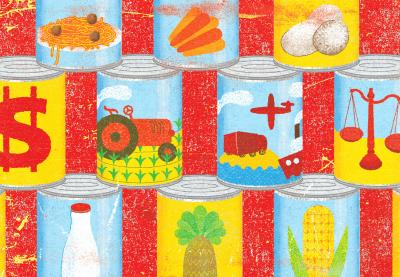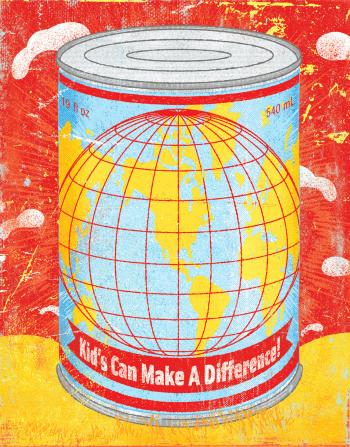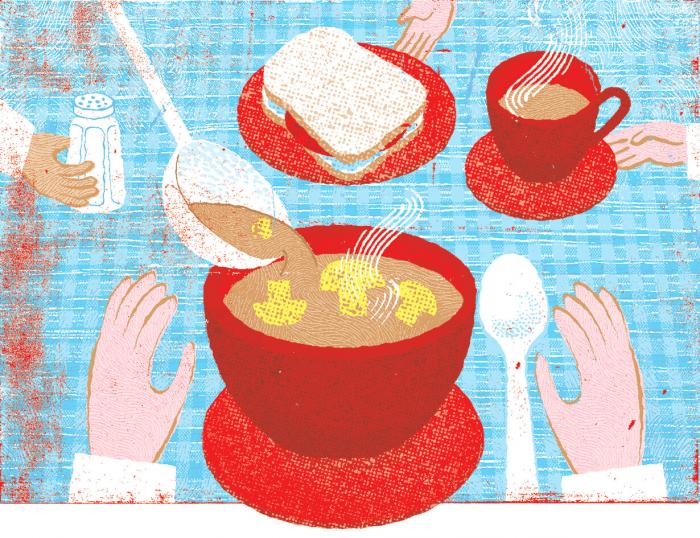As the holiday season nears, many schools will begin canned food drives — or toy drives, or coat drives or other donation drives for the "needy." Some will even turn it into a contest to see which class can collect the most goods.
Giving should be celebrated, yet charity projects can produce a damaging, unintended consequence: They can reinforce or exacerbate stereotypes students often hold about people living in poverty.
To guard against this side effect and to enrich students' knowledge, many educators are turning to service-learning. The model combines inquiry into poverty with charitable activities — and helps foster connections between students and the human beings they aim to serve.
The result? An emerging generation of socially conscious students dedicated to empowering others, as well as themselves.
Students at San Francisco University High School were used to the field trips to the poorer parts of town, to volunteer at the soup kitchen for a few hours at a time. The annual trips were intended to teach students about hunger and poverty in their community — but it turns out they were having the opposite effect.
"What we realized, when we were driving them back to school, was that (students) were saying the same things about hunger and poverty that they had been saying the day before," says Malcolm Singer, the director of community service-learning at this private, secular school for grades 9 through 12. "We realized we were reinforcing the same negative stereotypes."
Singer decided that if teachers were going to change students' attitudes about poverty, they needed to involve students with low-income communities in more meaningful ways.
As a result, the school introduced a host of service-learning courses, including two classes designed to challenge student stereotypes about people in poverty.
Now, class discussions focus on the root causes of poverty, like low wages, lack of affordable housing, and the ongoing reduction of social services. Informed and aware, students then identify a local problem, write an action plan, and work with the community to help their neighbors. Before the course ends, they take their message to other area schools.
Two years after taking a service-learning course, senior Andrea Imhof still volunteers with St. Anthony's Foundation in San Francisco's Tenderloin district, where she helps serve more than 2,000 daily meals and is working with the organization to improve its volunteer orientation program.
"Hunger and poverty are real, live problems in San Francisco and globally," Imhof says. "While most of the students and teenagers I know find it easy to avoid certain neighborhoods, it is impossible to ignore the problem completely when we are all sharing the same streets and city resources."
Education Before Action
More typical than the approach at San Francisco University High is the canned food drive — or winter coat drive, or holiday toy drive — generally done once a year around Thanksgiving or Christmas, at schools across the country.
While holiday food drives are well intentioned and usually meet a community need, they also can be problematic. Too often, holiday drives include little education about the root causes of poverty and almost no interaction between students and the community their donations are intended to help.
This can be detrimental for students in two ways. First, students miss out on a chance to learn about the social and economic structures under which everyone lives — rich, poor and in between. Second, this approach can reinforce negative stereotypes about poverty.
A program called Kids Can Make A Difference, also known simply as KIDS, turns this equation on its head.
The KIDS curriculum provides lesson plans that examine the underpinnings of hunger and poverty, followed by age-appropriate community service activities. The program encourages children to talk about hunger in their own communities, teach their families and friends what they've learned, and organize workshops for other classrooms and schools.
"You've got to get kids involved in the root causes of hunger instead of just collecting food. You have to start earlier in the year, not in November," says KIDS co-founder Larry Levine. "The children need to understand what the causes in society are that make us need to collect food."
What Is Service-Learning?
If canned food drives represent a "Band-Aid" solution to hunger, service-learning projects can represent the chance for a cure.
"Service-learning" combines community service with in-school curriculum, to the benefit of both the community and the classroom. First, students choose a social issue and investigate its causes. Then, students devise a community service project designed to address the issue. Following the service project, students reflect on what they learned.
Research shows that service-learning can reinforce skills learned in the classroom and improve students' interest in school. Research also shows an added benefit: When woven into the curriculum, community service can become an effective tool for teaching tolerance and reducing student bias.
According to the Northwest Regional Education Laboratory, which has provided research-based educational materials for 40 years, service-learning has been proven to:
- reinforce values of justice and compassion;
- help students develop a keener awareness of diversity;
- improve students' feelings of connection to their community.
By pairing community involvement with classroom learning, service-learning also increases the likelihood that students will gain a more nuanced understanding of social issues, and that they will learn to empower — not "help" — marginalized communities.
Making A Difference
Levine and his wife, Jane, started KIDS 13 years ago in classrooms across Maine. Now, their program is used in schools worldwide.
Palo Community School in Palo, Mich., is one of them.
As spring warms in Palo, hundreds of people gather inside the Palo Community School's gymnasium to break bread with friends and neighbors. Each May, Judy Huynh's 6th- and 7th-grade social studies class hosts this International Dinner to educate its community about global hunger and poverty.
Interestingly, many of Huynh's students are struggling themselves. More than half of the 137 students who attend the rural Palo Community School, grades K-8, receive free or reduced-fee lunches, and unemployment in the community is higher than the national average. During the winter months, school is sometimes canceled because the town doesn't have enough money to plow the snowy roads.
Huynh's students spend months preparing for the International Dinner. They build educational displays, divide the gym into different "countries," and present a slide show about world hunger.
Half of the proceeds raised from the event go to Heifer International, an organization that provides animals like goats and cows for families worldwide as sustainable sources of food and income.
Palo students use the rest of the money to buy items for the class's refugee pen pals. Money from last year's dinner helped purchase 17 soccer balls for children in Guinea.
"As teachers, it's our responsibility to teach our students about the issues of social justice in the world," Huynh says. "Once students become aware of the inequities in the world, they want to do something to make the world a better place."
In addition to the International Dinner, Huynh's students organize a hunger fair to teach peers about the inequitable distribution of wealth. They volunteer at the nearby Ionia County Food Pantry, bake cookies and desserts for the local soup kitchen throughout the school year, and distribute food from Gleaners Community Food Bank.
As a result, Huyhn's students are more informed about hunger and poverty than many adults.
Seventh-grader Skye Thomas, for example, can rattle off shocking facts about hunger: "Thirty thousand people die every day from hunger. A lot of them are kids under 5. There is a lot of food, but nobody wants to share."
Hunger Banquet Hits Home
Back in California, San Francisco University High School sends that message home by hosting a hunger banquet, scheduled every four years so each student will have an opportunity to participate. During the banquet, each student draws a piece of paper from a hat; what is written on the paper determines each student's economic status during the event.
The exercise is designed to reflect the inequitable distribution of world resources:
- Ten percent of the students draw the highest status and are served a feast of chicken, saffron rice, peas and salad.
- Twenty percent of the students draw "middle income" cards and receive a meal of salad, flavored rice and juice.
- The remaining 70 percent represent the lowest income bracket and are served only plain rice and water.
In order to deepen the lesson, only the top 10 percent are granted the privilege of sitting at the table; everyone else is relegated to squatting on the floor.
"It's very dramatic," Singer says. "We always have an open mic, and the kids talk about how it makes them feel to sit on the floor. Kids at the first world table talk about what it's like to live in such a world of privilege when there is so much need."
Singer says the event helps students get past taking things for granted: "It's not to be forgotten, and what we can do is keep reminding them."
Andrea Imhof agrees. The senior says she's seen a huge transition in the attitudes of students in her school because of the emphasis on service-learning: "It is only through intensive community service … that people become aware of the problems surrounding them and become involved in doing something to help."




0 COMMENTS